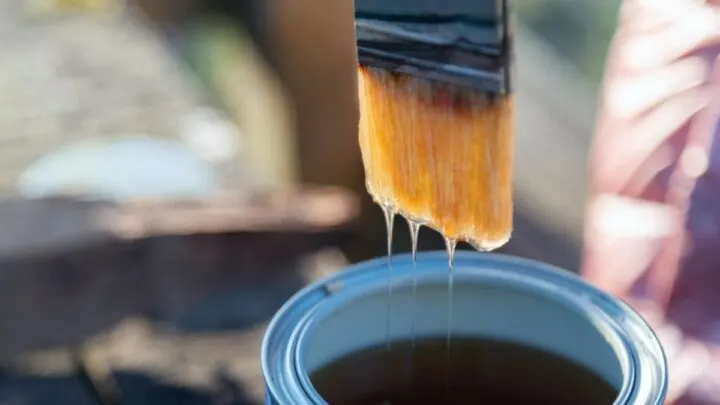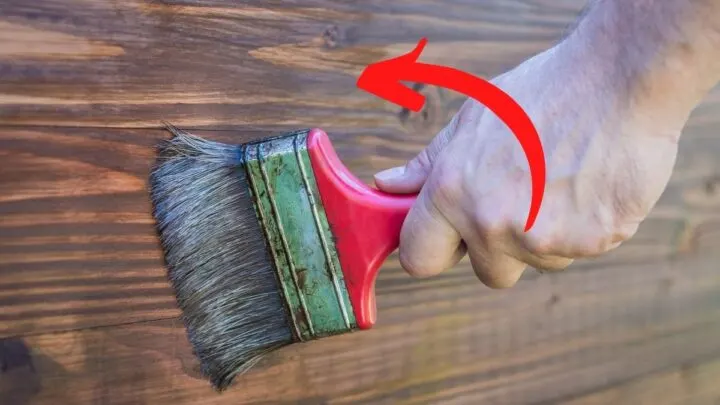It’s difficult to redo an entire room. Not only do you have to coordinate brand new colors to work with the existing colors, but you also have to make sure all the furniture looks like they came from a set.
A lot of homeowners are no longer in love with the classic wood look.
They don’t care about varnish anymore and they would like to paint over it to give their home or room to create a brand-new atmosphere.
So, do they have to remove the varnish before they paint over it, or can you paint over varnish?
You can paint over varnish. As long as the varnished is sandpapered first, painting over varnish should not be too hard. It’s important to also apply two or more layers of paint.
There are some paints you can and cannot use.
Be sure to have all the equipment before you get started. Besides the tools required in the middle of this article, you will also need a tarp, gloves, and sandpaper.
When working with chemicals, it’s a good idea to wear goggles to protect your eyes.
Can You Paint Over Varnish?
We are truly living through a home improvement and decoration boom.
Everyone on the internet, like decorations blogs, YouTubers, DIYers on social media platforms, and Pinterest lovers are inventing new looks and decoration styles.
Perhaps it is because of the pandemic, but people want to change the way their home looks.
Perhaps sitting in their house for months on end made them realize that they never invested in the interior design of their homes.
Many people have wood in their homes. They could be wooden cabinets, wooden decks, wooden furniture, hardwood floors, and wooden patio furniture.
They’re tired of staring at wood, so they get the idea to paint over the wood. But the one thing that is standing in their way is if they can apply regular paint to wood that has varnish applied to it already.
It is perfectly fine if you paint over varnish with paint. But there are some paints that you cannot use to paint over varnish.
It is much more difficult to even me paint over varnish with an oil-based paint, so decorators and DIY specialists recommend only using acrylic paints.
The acrylic paint should not be oil-based. It needs to be water based, and can also be a latex-based paint.
How to Prep Varnished Wood
Gather all the items you need and place them in a single workspace. Have everything you need in reach to make things easy for yourself.
Here’s how to prep the varnish wood and paint over it.

Step 1: Wash the Wood with Trisodium Phosphate.
Before you paint over any surface, wash it thoroughly to remove any oil, grime, dirt, or dust.
Even if it looks perfectly clean, there could be small particles on the surface, waiting to ruin you paint job.
Varnished wood needs to be washed with trisodium phosphate.
Trisodium phosphate is a special solution designed to remove old caked on oils, dirt, and grime. It will not destroy the chemical composition of the varnish.
While wearing gloves, pour some trisodium phosphate liquid onto a washcloth and wipe down any varnished surface that you plan to paint.
If there is a patch of cake-on substance that is not coming off, apply a bit more trisodium phosphate and scrub a little harder.
When finished, take a dry cloth and wipe away all the excess moisture. Then allow the piece to dry so that you can properly sandpaper it.
Step 2: Sand Down the Varnished Wood
Time, the elements, and collisions with moving objects can cause dents and scratches to form on the surface of the wood.
By sanding down the surface, you can create an even surface to paint on.
When sandpapering varnished wood, do not move the paper back and forth. The sandpaper needs to follow the grain of the wood.
When you reach the bottom of the wood, lift your hand back up and place it back at the top of the wood and then sandpaper it down again.
Once you’re finished sandpapering the entire surface does a varnished wood, take a wet cloth and wipe down the surface again.
You need to remove all the dust before the service can be painted.
Step 3: Apply Primer or Acrylic Paint
Before painting, place all the items you need to paint outside.
Painting inside a room or small space will not allow the chemical odor to dissipate. It can build up and make you feel lightheaded.
When painting the surface, it is better to use a paintbrush than a roller brush.
The paint brush will make it easier to paint over small fine details. If the varnish is dark, then you may need more than one coat of paint.
Once you are finished painting, allow it to dry overnight. Then look for any poorly painted patches where you can still see the varnish underneath.
Gently repaint these areas with a smaller brush than the brush that was used before.
Remove Varnish Using Varnish Stripper
If the sandpaper is not enough, then you can remove the varnish completely with varnish stripper.
Although it can get messy, varnish stripper is the most effective method of removing varnish.
You need gloves and a tarp for your workspace.
Is Wood Stain and Varnish the Same?
Both wood stain and varnish are applied to wood to change its color, but they’re not the same. They cannot be used interchangeably.
The fundamental difference between wood stain and varnish is that the wood stain soaks deep into the wood. Varnish acts like paint and simply sits on top of the wood.
It is much harder to remove stain from wood.
Conclusion to Painting Over Varnish
You cannot paint directly over varnish wood. It needs to be prepped and sandpaper first. Use trisodium phosphate to clean away oiled and grime.
Then, the varnished piece must be sandpapered, or else the paint will not stick to the surface.
Only use acrylic paint. Do not use oil-based paint.


